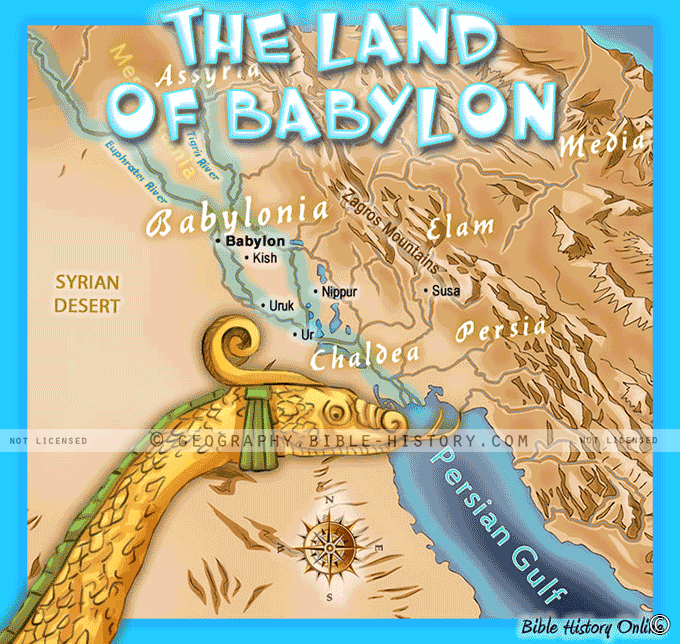
The Land of Babylon stands as an enigmatic and captivating realm, its name resonating through the ages as a symbol of ancient power, myth, and cultural significance. Situated between the Tigris and Euphrates rivers, this land was the cradle of remarkable civilizations, the backdrop for enduring tales, and the canvas upon which empires rose and fell.
Birthplace of Civilization
Babylon holds a special place in human history as one of the earliest centers of civilization. The Sumerians, Akkadians, Babylonians, and others left their indelible marks on this land, pioneering advancements in writing, agriculture, mathematics, and governance that shaped the trajectory of human development.
Tower of Babel: Myth and Symbolism
The myth of the Tower of Babel, echoing through biblical and cultural narratives, encapsulates the human aspiration for unity and the quest for reaching the heavens. This myth resonates with the complexities of language, communication, and the desire for knowledge that have marked our shared human journey.
Babylon's Golden Age
The city of Babylon, with its iconic Ishtar Gate and Hanging Gardens, reached its zenith under the rule of King Nebuchadnezzar II. Its advanced architecture, engineering, and urban planning showcased the achievements of an ancient civilization that left its mark on history.
Code of Hammurabi: Early Law and Governance
Babylon's legacy also includes the Code of Hammurabi, one of the earliest known legal codes. This collection of laws and regulations provides insights into social norms, justice, and the quest for a balanced society—an enduring concept that transcends time.
Cultural Exchange and Influence
Babylon's geographic location made it a hub for cultural exchange. Trade routes converged here, bringing with them ideas, beliefs, and technologies that enriched the region's tapestry of diversity.
Modern Discoveries and Preservation
The remnants of Babylon continue to captivate modern explorers, archaeologists, and historians. Efforts to uncover and preserve the historical treasures of this land shed light on the complexities of ancient urban life and the legacies that have shaped modern understandings.
The Land of Babylon is a realm where history, myth, and civilization intertwine, leaving an imprint on the human story. It's a place where the tower of human ambition touched the sky, where the rule of law was inscribed in stone, and where cultures converged to enrich the fabric of human existence. As we delve into the Land of Babylon, we journey through the rise and fall of empires, the echoes of myths, and the ongoing exploration of our shared human heritage.
Blank Topo Map of The World
Abraham’s Journey
The Captivity of Judah (586-516 B.C.)
The Fall of Judah 586 B.C.
The Northern Kingdom of Israel
The Southern Kingdom of Judah
The Divided Kingdom
The Fertile Crescent
Ur of the Chaldees
Shechem in Old Testament Times
Prophets, Kings, and Nations
Jesus Last Passover
New Testament Israel
New Testament Places
Old Testament Israel
Provinces of the Roman Empire
Israel during David’s Kingdom
David’s Kingdom
Cities of the New Testament 4
Cities of the New Testament 3
Cities of the New Testament 2
Mediterranean Sea
Cities of the New Testament
First Century Jerusalem
Empire of David and Solomon
David’s Kingdom
Israel Under Rehoboam
Ophir and Tarshish
The Period of the Kings
Ramoth Gilead
Samaria
Solomon’s Temple
Zarephath and MT Carmel
Jabesh Gilead and Tribes
Judah in the Time of David
Kingdom of Saul
Kirjath Jearim
Michmash
Mount Gilboa in the Time of David
Nob Davids Flight
Shiloh
Israel and Judah
Assyrian Empire Under Esarhaddon
Assyrian Empire Under Sennacherib
Captivity of 10 Tribes
Events in 2 Kings
The Khabur River
Israel and Syria
Captives From Judah
Kingdom of Jeroboam
Mesha’s Kingdom
Pharaoh Necho Battles King Josiah at Megiddo
Babylonian, Mede and Persian Empires
Samaria and Nearby Territories
Syria at its Height
Hebron
Mahanaim
1949 Map of Israel With Boundaries
First & Second Journeys of Paul
Journeys of the Apostles
Paul’s Third Missionary Journey
Saul’s Journey to Damascus and Arabia
Paul’s Final Visits
Paul’s 1st Missionary Journey
Paul’s 2nd Missionary Journey
Paul’s 3rd Missionary Journey
Paul’s Voyage to Rome
Phillip Journeys to Samaria and Gaza
Judah at the Time of Amos
Empire of Alexander the Great
Israel Under the Maccabees
Galilee During Maccabees
Idumea Intertestamental Period
Kingdom of the Ptolemies
Kingdom of the Seleucids
Ptolemaic Egypt Seleucid Asia
The Roman World
Kingdom of Ptolemies and Seleucids
The World During the 6TH Century BC
Mount Horeb
The Red Sea
The Exodus
Ezra’s Journey to Restore Jerusalem
Israel and Judah During Hosea’s Time
The Ancient World
Canaan During the Time of Abraham
The City of Shechem
Supposed Location of the Garden of Eden
The Land of Israel in Genesis
The Jordan River
The Kingdom of Nimrod
Mount Ararat and Mesopotamia
The Descendants
Sodom and Gomorrah
The Kingdom of Egypt
The Hamites
The Kingdom of the Hittites
Ur of the Chaldees
Judah at the Time of Haggai
Jesus Passes Through Samaria
